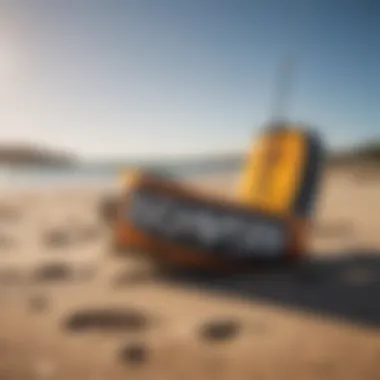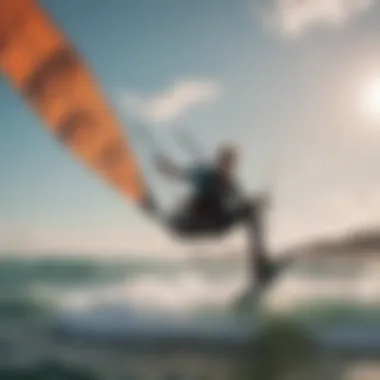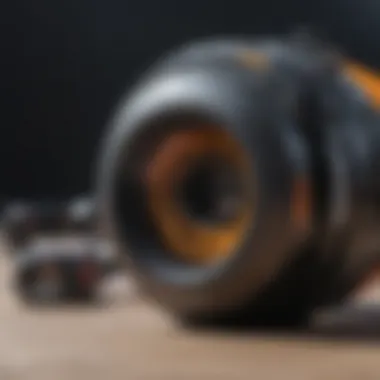Your Ultimate Guide to Buying Kitesurfing Gear


Intro
Kitesurfing is a thrilling sport that combines aspects of surfing, windsurfing, and paragliding. As you explore the currents or ride the waves, the right equipment can significantly enhance your experience. This guide aims to assist both newcomers and experienced enthusiasts in navigating the marketplace of kitesurfing equipment. You will learn about key factors to consider, emerging technologies, and how to avoid common pitfalls. The information provided here aims to empower you to make informed choices, ensuring that you can fully enjoy and engage in this exhilarating sport.
Techniques and Tips
Skill Development
Before diving into your purchase, understanding your skill level is crucial. Kitesurfing requires practice and familiarity with the equipment. Beginners should focus on learning the basics of kite control and board management before making any investments. Consider taking lessons from certified instructors to build a strong foundation. This foundational skill can help in selecting the right gear to match your progress as you advance.
Practical Techniques
When beginning, pay attention to your stance and body positioning. Maintain a balanced posture while handling the kite. Learn essential techniques such as "upwind riding" and "transitioning between directions." These techniques are vital for navigating effectively and will dictate the type of gear that best suits your needs as you progress.
Common Mistakes to Avoid
Many beginners tend to overlook the importance of purchasing gear tailored to their weight and skill level. Choosing a kite that is too large can make handling difficult and lead to dangerous situations. Additionally, neglecting maintenance is another common mistake. Proper care of kites and boards extends their usability and ensures safety.
Gear and Equipment
Essential Gear for Beginners
For those just starting, a basic setup includes a kite, board, harness, and safety gear. A typical choice includes:
- Kite: A 12-15m inflatable kite is ideal for lighter winds.
- Board: A twin-tip board offers ease of use.
- Harness: A comfortable harness is essential for long sessions.
- Safety Gear: Include a helmet and impact vest.
Latest Innovations and Trends
The kitesurfing industry is evolving. Recent trends focus on advanced materials and designs that enhance performance and durability. Look for:
- Lightweight kites for improved handling.
- Adjustable fins on boards for customization.
- Smart technology integrations, like real-time wind data apps.
Reviews and Comparisons
Consider checking independent reviews on platforms such as Reddit or specialized forums dedicated to kitesurfing. Reviews help uncover differing opinions on gear, offering insights into what may work best for your style and budget.
Safety Measures
Essential Safety Gear
Safety should always be a priority. Essential gear includes:
- Impact vests: Protects against surf and board impacts.
- Helmets: Reduces head injuries.
- Leashes: Prevents losing your board in the water.
Best Practices for Safe Participation
Always check the wind conditions before heading out. Familiarize yourself with local regulations and potential hazards at the kite spot. Kitesurfing in groups is advisable, especially for beginners, as it allows for instant help.
Injury Prevention and Management
Warming up before your session can minimize injuries. Keep a first-aid kit handy and know basic injury management practices. Stay aware of your physical limits, and do not push yourself too hard too quickly.
Spotlights on Extreme Sports
Featured Sport of the Month
This section will highlight a different extreme sport each month. The focus will be on new trends and innovations, providing a broader view of the adventurous sports landscape.
Profiles of Prominent Athletes
Reading about accomplished kitesurfers can provide inspiration and learning. Look for biographies or interviews that unveil their training routines and insights into gear selection, which could be beneficial for your own kitesurfing journey.
Understanding Kitesurfing Equipment
Understanding kitesurfing equipment is the foundation of an enjoyable and safe experience on the water. Selecting the right gear is not just about aesthetics but also about performance, safety, and personal preferences. Each component plays a distinct role and can significantly impact the way one rides the waves. A well-informed choice leads to improved performance and a deeper connection to the sport.
It is vital to recognize the essential components of kitesurfing gear to make educated decisions. Knowing how each piece of equipment works together enables kitesurfers to customize their setup according to their skills and conditions. Every element, from the kite to the control bar, has its specific characteristics and advantages that enhance the thrilling experience kitesurfing can offer.
The Essential Components of Kitesurfing Gear


Kite Types
Kite types are a crucial aspect of kitesurfing equipment. There are several styles of kites, such as inflatable kites, which are popular for their stability and ease of use. Another option is the foil kite, recognized for its efficiency in flight. Each type serves different riding needs and preferences.
The key characteristics of kite types can influence choice significantly. For instance, inflatable kites are typically made of durable materials and provide consistent power. They also tend to handle a wide range of wind conditions effectively, which is beneficial for many riders. In contrast, foil kites may require more skill but can perform exceptionally well in light winds, thus showcasing their advantage.
Boards
The choice of board is another fundamental element of kitesurfing gear. Boards come in various shapes and sizes, catering to different styles like freestyle, freeride, and wave riding. A larger board allows for easier transitions and stability, especially for beginners.
The key characteristic of boards lies in their design, which affects performance on the water. For instance, directional boards are designed specifically for wave riding but may not be as versatile as twin-tip boards used for tricks. Each type brings unique benefits and limitations depending on riding conditions and skill level.
Harnesses
Harnesses play a significant role in connecting the rider to the kite. They distribute the pull from the kite across the body, relieving strain on the arms and enhancing control. Selecting the right harness depends on comfort and riding style.
These harnesses can be categorized into waist and seat styles, each with distinct advantages. Waist harnesses allow for greater maneuverability but may not provide as much support during high-power sessions. Meanwhile, seat harnesses tend to be more comfortable for those just starting out, especially in challenging winds.
Control Bars
Control bars are critical for managing the kite's power and direction. They come with essential features like safety systems and adjustable lengths. The right control bar allows for precision in steering and easy access to depower functions.
A key characteristic of control bars is their line length; longer lines can give more power, while shorter lines offer quicker responsiveness. The specific design of control bars influences how comfortable and confident a rider feels while managing the kite.
The Importance of Quality in Equipment
When purchasing kitesurfing equipment, quality cannot be overlooked. The durability and reliability of gear can greatly enhance performance and safety. Choosing equipment made from high-quality materials ensures longevity and better performance, ultimately saving costs in the long run.
Material Durability
Material durability is a vital aspect to consider when selecting kitesurfing gear. Equipment is often put to the test under harsh conditions, and high-quality materials can withstand such challenges. For example, kites made from ripstop nylon resist tears and abrasions more effectively, contributing to their extended lifespan.
Durability also affects performance capabilities. Equipment that deteriorates quickly can lead to safety risks, particularly during extreme conditions. Therefore, selecting gear that is built to last supports not only longevity but also the rider's safety and performance.
Performance Specifications
Performance specifications are key indicators of how well kitesurfing gear will perform in various conditions. Items such as wing area, aspect ratio, and volume characterize how the equipment interacts with water and wind. Each specification serves a purpose and can be beneficial for specific riding styles or conditions.
High-performance gear can lead to increased speeds, better air time, and overall improved riding experiences. Conversely, lower-quality gear may not meet the demands of certain riding styles or large waves, making it important to ensure that there is a match between equipment specifications and the rider's ambitions.
Safety Features
Safety features are an essential consideration when choosing kitesurfing equipment. These features may include quick-release systems, safety lines, or impact protection. A well-designed safety feature can safeguard riders from potential entanglements or falls.
Quality brands invest in effective safety mechanisms to ensure the well-being of users. A lack of such features can lead to serious consequences during unpredictable conditions. Therefore, prioritizing safety features in gear selection is paramount for any kitesurfer, regardless of skill level.
Remember that understanding your equipment is key to maximizing your kitesurfing experience. Making informed decisions leads to both enjoyment and safety.
Evaluating Your Skill Level and Needs
Understanding your skill level and personal needs plays a crucial role in purchasing kitesurfing equipment. This evaluation helps you identify which gear aligns best with your abilities and intended riding style. Choosing the right equipment can significantly enhance your experience, ensuring that you feel confident and safe on the water.
Beginner vs. Advanced Gear
Kite Size Selection
Kite size is a critical factor in kitesurfing. Different sizes cater to varying wind conditions and rider abilities. Beginners often benefit from larger kites, which provide more lift and easier control. A larger kite can help a novice stay afloat in lower wind conditions, making the learning process less intimidating.
On the other hand, advanced riders typically prefer smaller kites that offer better maneuverability and responsiveness. Smaller kites are suited for strong winds, allowing skilled riders to perform tricks with precision. When selecting a kite size, consider your weight and typical wind conditions in your area.
"Selecting the correct kite size is essential to align with your skill level and environment."
Board Types for Different Levels
The type of board you choose should reflect your skill level and experience. Beginners should opt for a wider board, which provides stability and easier planing. A wider board allows for a smoother ride, perfect for those just starting.
As riders progress, they might explore different board shapes. Advanced boards tend to be narrower and lighter, offering performance benefits such as quicker turns and better speed. Each type of board has its unique features, which cater to specific riding styles. Familiarizing yourself with these options empowers you to make an informed choice.
Understanding Your Riding Style


Freestyle
Freestyle riding, characterized by jumps and tricks, requires specific equipment to enhance performance. This style typically demands a kite with a higher aspect ratio to improve lift and control during aerial maneuvers. Freestyle kites are engineered for responsiveness, crucial for executing complex tricks. However, these kites can be challenging for beginners, primarily due to their performance-specific nature.
Waves
Wave riding presents unique challenges and excitement. Riders navigating waves benefit from specially designed equipment tailored for agility and sustainability. Kites suitable for waves tend to be smaller and equipped for easy turning. They help in maintaining speed and control, essential when gliding down the face of a wave. The downside may include a steeper learning curve compared to flat-water riding.
Lightwind
Lightwind kitesurfing is focused on maximizing performance in low-wind conditions. These kites usually feature larger surface areas and are designed to create more lift. The advantage here is the ability to kite when others cannot.
However, these kites may not react as well in stronger winds, which can limit their versatility. Understanding your typical conditions will help you select appropriately between lightwind and other styles.
By evaluating your skill level and riding style, you can better navigate the diverse options available in the kitesurfing market.
Researching Brands and Manufacturers
When it comes to kitesurfing, choosing the right equipment is only part of the process. Researching brands and manufacturers is just as crucial. This step ensures you invest in high-quality gear that meets your needs and expectations. Understanding the reputation of different brands can improve the overall experience rather than leaving you with subpar products or costly mistakes.
Reputable Brands in Kitesurfing
Brand History and Reliability
Brand history stems from their experiences and expertise in the kitesurfing industry. Reliable brands like Naish or Cabrinha have built credibility over the years. Their long-standing history indicates they understand what kitesurfers require. This reliability often translates to quality materials, innovative designs, and effective customer support. Having a known brand can give users peace of mind. A strong track record supports a confident purchasing decision but remember that newer brands may also offer unexpected advantages.
Customer Reviews
Customer reviews offer insight into real-world performance. Reading feedback from other kitesurfers provides practical insights that specifications alone cannot. Comprehensive reviews highlight not only the positives but also any potential issues. Consider the volume and patterns of feedback when evaluating gear. A product with consistent praise or constructive criticism will likely perform well or meet expectations. It is valuable to combine these reviews with first-hand experiences before deciding on a brand.
Warranty and Support
Warranty and support from manufacturers can shape your purchasing strategy. A strong warranty provides assurance that the brand believes in its product's longevity. Brands such as North Kiteboarding often offer extensive warranties which can be beneficial. Support options, including live chats or phone consultations, help users navigate any issues that arise post-purchase. The right warranty can prevent future headaches, while excellent support builds ongoing relationships between users and brands.
Emerging Brands to Consider
Innovative Technology
Emerging brands often focus on innovative technology, setting them apart from established competitors. Brands like F-One regularly introduce advancements, from lighter materials to enhanced control systems. These innovations can lead to better performance on the water. Recognizing such aspects becomes valuable when considering the latest trends in kitesurfing. Trying out newer technology can result in improved experiences and may alter your techniques altogether. Competition among brands ensures continued evolution in gear, which may benefit users willing to explore.
Niche Market Features
Niche market features are another consideration when evaluating new brands. Some manufacturers target specific segments, like wave riding or freestyle. These brands craft specialized products tailored to these audiences. Exploring brands such as Slingshot can reveal unique innovations that larger companies may overlook. Niche features can sometimes lead to a more customized kitesurfing experience. Therefore, understanding how these specialized offerings align with your needs is essential.
Cost Considerations
Understanding cost considerations is essential when purchasing kitesurfing equipment. This topic encompasses not only the initial expenditure but also long-term financial implications. There are many factors that influence the cost of kitesurfing gear. By evaluating these factors, you can make informed decisions that align with your budget and surfing goals.
Budgeting for Kitesurfing Equipment
Initial Investment vs. Long-Term Costs
When buying kitesurfing equipment, the initial investment entails the upfront costs of gear such as kites, boards, and safety equipment. This can be significant, especially for high-quality gear. However, it is crucial to consider the long-term costs as well. Cheaper options may save money initially but could lead to higher expenses later on due to frequent replacements or repairs. Thus, investing in durable equipment often proves to be wiser, potentially extending the lifespan of your gear and reducing costs over time.
The key characteristic of understanding initial vs. long-term costs is knowing how your choices impact future finances. A beneficial aspect of this consideration involves weighing the value of quality against price. Investing in top-notch brands might appear costly at first, but they generally offer better materials and superior performance.
Used Equipment Options
Exploring used equipment options presents an alternative to buying new products. The primary benefit of this choice is the lower price tag associated with secondhand gear. Enthusiasts can often find quality equipment that is still functional at a fraction of the cost. This appeals to budget-conscious buyers or those just starting in the sport.
However, the unique feature of acquiring used gear lies in the condition of the equipment. It is critical to inspect the gear for wear and tear. Sometimes, cheaper used items can require significant repairs or may not perform as well as new items. This means that while purchasing used gear might seem like a good deal, consider the potential long-term problem of repairs that could offset those savings.
Seasonal Discounts and Promotions
Timing Your Purchase
Timing your purchase is vital to making economical choices. Many brands and retailers offer seasonal discounts that can significantly reduce costs. Planning purchases around key periods can allow one to acquire better equipment at lower prices. This considerations can lead one to enjoy high-quality kitesurfing gear without stressing finances.
The key characteristic here is the ability to capitalize on sales events. This often results in better deals on last season's gear or promotional events that retailers host during peak seasons. By learning when these sales happen, you can maximize savings while still acquiring the most suitable equipment.


Sign Up for Deals
One effective way to stay informed about discounts is to sign up for deals from retailers. Many companies offer newsletters or alerts that include current promotions, exclusive discounts, or early bird offers. Joining these lists can be beneficial as it ensures that you don’t miss out on any savings opportunities.
Additionally, the unique feature of subscribing is that it often leads to access to exclusive rewards for loyal customers. These rewards can provide further discounts or even special deals over time. While it adds another step in the purchasing process, being proactive about promotions can lead to significant savings in the long run.
"Understanding cost considerations can lead to smarter purchasing decisions in kitesurfing, helping you enjoy your sport without financial strain."
Where to Buy Kitesurfing Gear
Choosing where to buy your kitesurfing gear is a vital part of the purchasing process. The decision can influence not only the quality of your experience but also affect your budget and satisfaction. Understanding the nuances between different purchasing options helps you to select the best channel for your specific needs. You will encounter a mix of online retailers and physical shops, each with its distinct advantages and hardships. Evaluating these aspects will guide you in making an informed choice that aligns with your preferences and circumstances.
Online Retailers vs. Brick-and-Mortar Stores
Advantages of Online Shopping
Online shopping offers convenience that is highly sought after. You can easily browse multiple websites, compare prices, and read reviews without needing to leave your home. This is particularly helpful for kitesurfing gear, as there are many types that you may want to research before committing to a purchase.
A key characteristic of this option is the extensive variety available. Online marketplaces like Amazon, eBay, and specialized sports websites provide access to an extensive selection of kites, boards, and accessories. One compelling unique feature is the possibility of finding deals or discounts that may not be available in stores, making online shopping an economically favorable choice for most buyers. However, one should bear in mind the drawbacks, such as shipping costs and the inability to physically inspect the gear before buying.
Benefits of Physical Stores
Physical stores present a different set of benefits. The most significant aspect is the personal experience you gain. You can interact with sales staff who often have firsthand knowledge of kitesurfing equipment. This can be particularly important, as their insights can assist you in making more precise choices tailored to your needs.
A notable characteristic of visiting a store is the tactile experience. You are able to feel the materials, the weight of the equipment, and compare different models side-by-side. The unique feature of engaging experts and receiving personalized recommendations can enhance confidence in your purchases. Nonetheless, prices in brick-and-mortar stores might be higher due to overhead costs, which is a consideration worth weighing against buying online.
Local Shops and Community Support
Expert Advice
When buying from local shops, one of the primary benefits is access to expert advice. Local retailers frequently employ experienced staffers who are enthusiastic about kitesurfing. They can offer tailored recommendations on gear that best suits your skill level and riding style.
This expert guidance is often an invaluable resource, enabling you to avoid common pitfalls that new kitesurfers may encounter. It provides added reassurance, making local shops a great choice for many individuals who prioritize getting it right the first time. However, depending on the store, this service may come alongside a higher price point.
Test Opportunities
Another significant aspect of shopping locally is the opportunity for test experiences. Many local shops host demo days where you can try equipment before you make a purchase. This allows you to assess how different kites and boards handle, providing firsthand experience that online shopping cannot offer.
The unique feature of trying gear before buying it cannot be overstated. It ensures that the chosen equipment matches your expectations and provides a more tailored fit to your riding style. While these opportunities may not exist at every store, the presence of such options can greatly enhance your purchasing decision and enjoyment of the sport.
Overall, evaluating where to buy kitesurfing gear must incorporate the understanding of both online and in-person options. Each has its pros and cons, and for many, a combination of both will yield the best results.
After Purchase Considerations
After your purchase of kitesurfing equipment, consider what comes next. This phase is vital, as it directly affects the longevity and performance of your gear. Understanding how to maintain your equipment and knowing when to upgrade can enhance your kitesurfing experience significantly.
Proper Gear Maintenance
Cleaning and Storage
Cleaning and storage are key aspects of maintaining kitesurfing gear. Regular cleaning removes sand, salt, and dirt that can degrade equipment over time. It is essential to rinse your kite and other gear with fresh water after each use. Proper storage involves keeping your gear in a cool, dry place, away from direct sunlight.
The main characteristic of cleaning and storage is its impact on durability. By frequently cleaning your gear and storing it correctly, you prevent premature wear. This practice is beneficial because it extends the life of your investment, giving you more time on the water. However, improper storage, such as leaving it in a damp area, can lead to mold and mildew, which can compromise your gear's integrity.
Periodic Inspections
Periodic inspections are also crucial. By checking your kite, board, and other equipment regularly, you can identify potential issues before they become significant problems. Look for wear and tear on the lines, fabric, and harness. These inspections contribute to your safety and performance on the water.
The distinctive feature of periodic inspections is the proactive approach it encourages. Often, ignoring minor damages can lead to costly repairs or replacements later. This is advantageous for any kitesurfer, from beginner to advanced. On the downside, periodic inspections require time and attention, which some may overlook.
Upgrading Your Equipment
Recognizing When to Upgrade
Recognizing when to upgrade your kitesurfing gear will help you achieve optimal performance. Several signs indicate that it might be time for an upgrade, such as noticing a decrease in performance or if your gear does not meet current riding styles or advancements in technology.
This recognition is significant because it keeps your experience enjoyable and safe. Upgrading benefits riders who actively change their skills or preferences. However, some might hesitate to spend again after a recent purchase, possibly missing out on improved performance.
Resale or Trade-In Options
Considering resale or trade-in options can also be beneficial. After upgrading, many find value in selling their old gear instead of letting it gather dust. This option can help mitigate the costs of new gear. Resale allows you to recoup some of your initial investment while trading in offers convenience and has specific trade-in incentives.
The primary advantage of resale or trade-in is financial savings. It provides a pathway to exchange your old gear for discounts on new purchases. Some drawbacks include the potential hassle of selling equipment and waiting for the right buyer.
Always assess your gear's condition before deciding to sell. A well-maintained item will fetch a better price.







